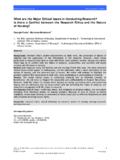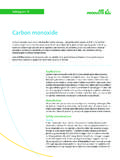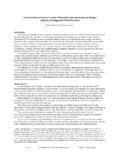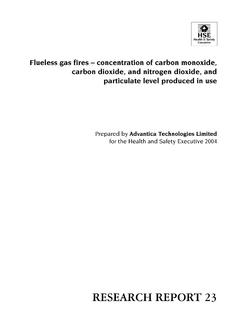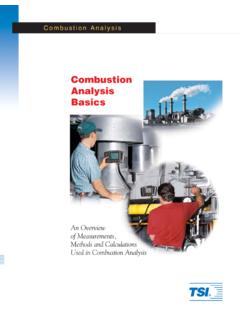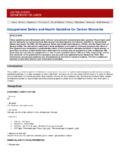Transcription of Effects of Smoking on Cardiovascular Function: …
1 HHEEAALLTTHH SSCCIIEENNCCEE JJOOUURRNNAALL VOLUME 8 (2014),ISSUE 2 E-ISSN:1791-809x Published by Department of Nursing , Technological Educational Institute of Athens P a g e | 274 SPECIAL ARTICLE Effects of Smoking on Cardiovascular Function: The Role of Nicotine and carbon monoxide George Papathanasiou1, Anastasia Mamali2, Spyridon Papafloratos3, Efthimia Zerva4 1. PhD, Assistant Professor, Physical Therapy Department, Technological Educational Institution of Athens (TEI-A), Greece 2.
2 Physical Therapy Department, Technological Educational Institution of Athens (TEI-A), Greece 3. Physical Therapy Department, Technological Educational Institution of Athens (TEI-A), Greece 4. PhD, Lecturer, Physical Therapy Department, Technological Educational Institution of Athens (TEI-A), Greece Abstract Smoking is a major risk factor for Cardiovascular morbidity and mortality, and is considered to be the leading preventable cause of death in the world. Cigarette smoke contains more than 4000 chemical substances, including nicotine and carbon monoxide (CO) that can have harmful Effects on Cardiovascular function.
3 These basic ingredients of tobacco smoke cause an increase in oxidative stress, endothelial damage and dysfunction, and are associated with significantly higher serum concentrations of total cholesterol and triglycerides, and lower levels of the cardioprotective high-density lipoprotein. By causing intravascular inflammation, Smoking promotes the development of atherosclerosis and Cardiovascular disease. The purpose of this article is to provide a brief description of the Effects of Smoking , and in particular the Effects of nicotine and CO, on Cardiovascular function.
4 Nicotine deregulates cardiac autonomic function, boosts sympathetic activity, increases heart rate (HR) at rest, while blunting HR elevation during progressive exercise and lowering the maximum HR that can be achieved. At the same time, the Smoking -generated CO binds with haemoglobin and myoglobin, reduces arterial O2 blood saturation, compromises the efficiency of respiratory enzymes, and causes dysfunction of the O2 production, transportation and delivery system, especially during exercise, substantially reducing the functional capacity and the performance of the circulatory system.
5 Keywords: Cardiovascular disease, circulatory system, Smoking , tobacco Corresponding author: George Papathanasiou: Proussis 22, Athens 17123, Greece Telephone: +306942408757, e-mail: Introduction Smoking is a major risk factor for Cardiovascular morbidity and mortality, and is considered to be the leading preventable cause of death in the ,2 Internationally, 25% of middle-aged Cardiovascular deaths are attributable to The European Society of Cardiology reported recently that Smoking causes 28% of Cardiovascular deaths in men aged 35 to 69 years and 13% in women of the same In the European Region of the World Health Organisation (WHO)
6 , Smoking is the second most important risk factor in the burden of disability-adjusted life years and is the primary risk factor for premature mortality, associated with about million deaths each In the European Union (EU), 15% of all-cause deaths are attributed to Smoking , amounting to 655,000 Smoking -related deaths each year,6 while in Greece, the percentage of deaths from any Smoking -associated cause, among individuals ages 35 and older, has been estimated to be Based on estimates by the WHO, tobacco continues to kill nearly 6 million people each year including more than 600,000 passive smokers through VOLUME 8 (2014)
7 ,ISSUE 2 HHEEAALLTTHH SSCCIIEENNCCEE JJOOUURRNNAALL Effects of Smoking on Cardiovascular Function: The Role of Nicotine and carbon Science ;8 (2) P a g e | 275 heart disease, lung cancer, and other illnesses;1 that is one and a half million more than the corresponding estimate for If current trends continue, the death toll is projected to reach more than 8 million per year by Smoking ranks among the top causes of Cardiovascular disease, including coronary heart disease, ischemic stroke, peripheral artery disease and abdominal aortic It is also associated with an increased risk of certain types of cancer, and is a major cause of chronic obstructive pulmonary ,2 Smoking , either active or passive.
8 Can cause Cardiovascular disease via a series of interdependent processes, such as enhanced oxidative stress, haemodynamic and autonomic alterations, endothelial dysfunction, thrombosis, inflammation, hyperlipidaemia, or other Even exposure to small quantities occasional Smoking , passive Smoking , a few cigarettes per day is sufficient to have deleterious Cigarette smoke contains more than 4000 chemical substances that have harmful Effects on Cardiovascular These include nicotine, carbon monoxide (CO), oxidative gases, polycyclic aromatic hydrocarbons, carbonyls, butadiene, minerals, carbon disulphide, and benzene.
9 Although many of the toxic substances contained in tobacco smoke are generic products of the combustion of organic materials, exposure to Smoking involves contact with two substances that are specific to tobacco smoke and are known to be damaging to the health: nicotine and Despite all the publicity concerning the documented adverse Effects of Smoking on public health, Smoking prevalence still remains high in the EU, where approximately 30% of citizens are Greece suffers from an enormous Smoking -related public health problem, having the highest proportion of smokers in the EU (42%).
10 12 According to WHO estimates, in Greece of adult males and 39% of females 15 years are smokers,13 while in young adults, aged 19-30 years, the Smoking prevalence is The purpose of this article is to provide a brief description of the Effects of Smoking , and in particular the Effects of nicotine and CO, on Cardiovascular function, providing essential information that could contribute to reducing the Smoking epidemic and its consequences for Cardiovascular health. NNiiccoottiinnee Nicotine is classed as an alkaloid (like morphine and cocaine) and meets the criteria of a highly addictive drug.
